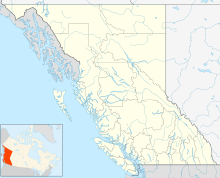| Canoe River train crash | |
|---|---|
 | |
| Details | |
| Date | November 21, 1950 10:35 a.m. |
| Location | south of Valemount, British Columbia 396 km (246 mi) west-southwest from Edmonton |
| Coordinates | 52°45′48″N 119°15′54″W / 52.76333°N 119.26500°W |
| Country | Canada |
| Line | Transcontinental mainline |
| Operator | Canadian National Railways |
| Incident type | Head-on collision |
| Cause | Words omitted from order to troop train, causing it to proceed rather than pull onto a siding. |
| Statistics | |
| Trains | 2 |
| Deaths | 21 |
| Injured | 61 |
The Canoe River train crash occurred on November 21, 1950, near Valemount in eastern British Columbia, Canada, when a westbound troop train and the eastbound Canadian National Railway (CNR) Continental Limited collided head-on. The collision killed 21 people: 17 Canadian soldiers en route to the Korean War and the two-man locomotive crew of each train.
The post-crash investigation found that the order given to the troop train differed from the intended message. Crucial words were missing, causing the troop train to proceed on its way rather than halt on a siding, resulting in the collision. A telegraph operator, Alfred John "Jack" Atherton, was charged with manslaughter; the Crown alleged that he was negligent in passing an incomplete message. His family hired his Member of Parliament, John Diefenbaker, as defence counsel. Diefenbaker joined the British Columbia bar to take the case, and obtained Atherton's acquittal.
After the accident, the CNR installed block signals on the stretch of track on which the crash occurred. The railway later realigned the main line in that area, eliminating a sharp curve that prevented crews from seeing oncoming trains. Diefenbaker's successful defence of Atherton became an asset in his political rise. A number of monuments honour the dead.
